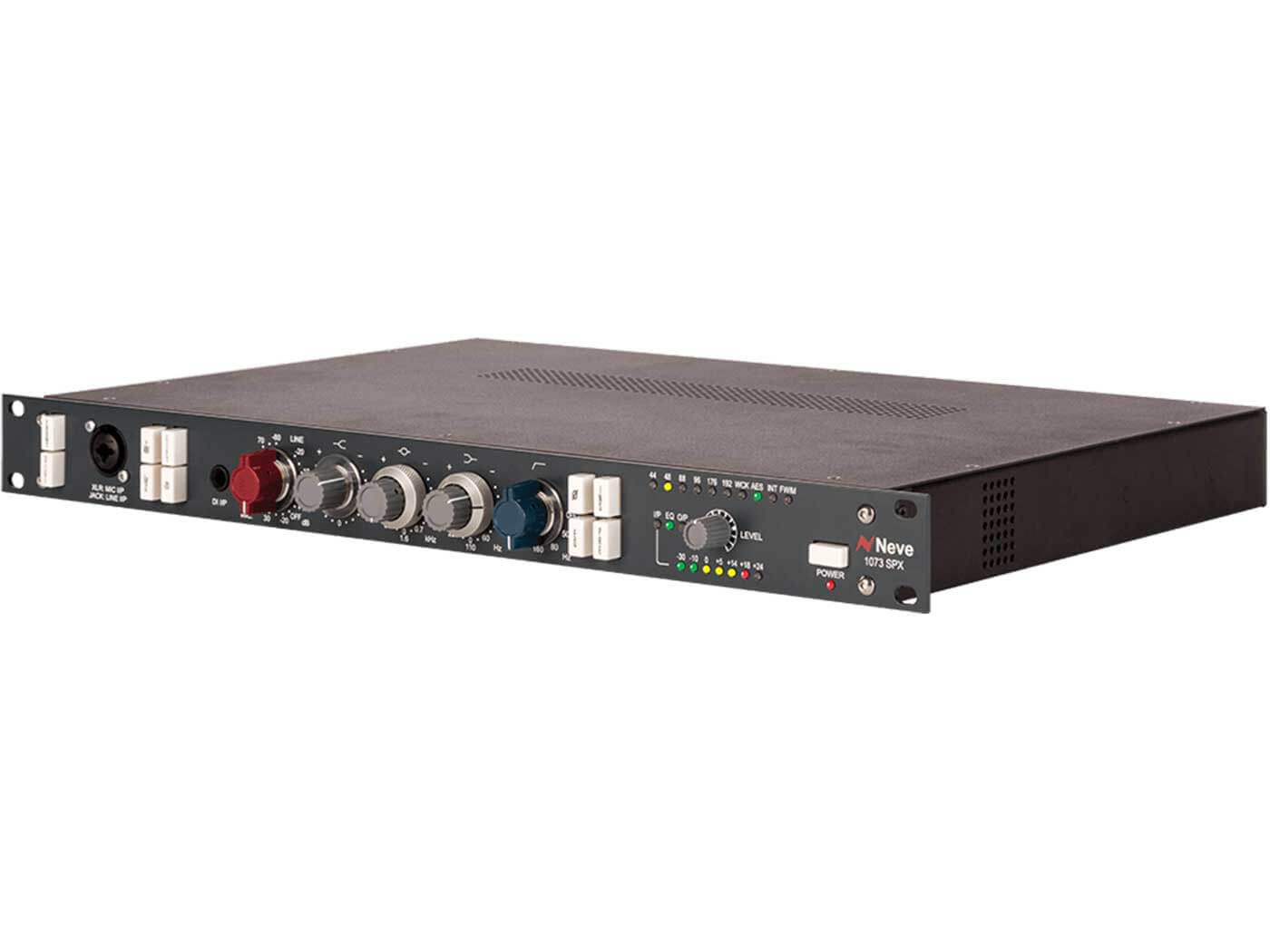Neve 1073 SPX Review – A Modern Incarnation Of A Sonic Icon
Neve’s legendary mic preamplifier receives a modern makeover, with input from the original designers. John Pickford puts the SPX through its paces…


Price £1,695
Contact AMS Neve Ltd 01282 457011
![]()
1073 SPX key features
- Exclusive Neve Marinair transformers
- Greyhill switches and pots
- Three-band EQ section
- 80dB input gain
- Front-panel Mic, Line and DI inputs
- Insert send-and-return loop
Ask any number of recording engineers to name a classic make of mixing console and chances are the top answer will be – give or take the odd SSL – Neve. Push them further to identify the company’s most revered design and the reply will almost certainly be the 1073. As legendary analogue recording equipment goes, the Neve 1073 microphone preamplifier is right up there with Neumann mics, Pultec equalisers and Fairchild limiters.
While those vintage designs date back to the 1950s, the 1073 module first appeared in 1970, housed in the A88 console designed by Rupert Neve for Wessex Studios. This was an exciting time for pro audio in the UK; eight-track recording enabled producers and engineers to create expansive recordings far in advance of the tinny pop records of the 1960s, and 16-track was just around the corner.
On test here is AMS Neve’s latest reproduction of its classic design – the 1073 SPX. A pure Class A solid-state design, the 1073 SPX incorporates a single-channel mic preamp with a three-band equaliser.
Housed in a 1U 19-inch rack-mountable case and beautifully finished in Neve’s familiar grey colour, the unit is solidly built and laid out in classic 1073 style. An optional digital input/output module providing AES and FireWire connectivity at a range of sample rates will be made available in mid 2018 and can be easily retrofitted; our review sample is pure analogue.
Designed by Neve’s highly skilled engineers, the team includes John Turner and Robin Porter, both of whom have been with the company for decades. These men were working for Neve when the first 1073s were built and know the model intimately.
Their precise measurements and definitive listening tests ensure that these new units perform just as the originals did when new. Vintage-gear junkies may well lust after original 1073 modules from the 1970s; however many of those old units will likely be way off-spec by now, especially if internal components have been replaced with inferior ones.
Under the bonnet
The SPX employs Neve’s bespoke Marinair transformers on the both the input and output stages and their performance is crucial to the true 1073 sound. Top-quality Greyhill pots and switches also contribute to the genuine feel and performance of the unit, while metal film resistors and through-hole components for coupling capacitors, EQ capacitors, signal transistors and EQ inductors are used internally.
Microphone and Line inputs can be accessed on both the front and rear of the unit; the white push-button switch labelled Front must be engaged to route the audio to the combo connector on the front panel. Input gain for both microphones and line-level sources is selected via a single rotary switch, configured in the traditional Neve style, providing up to 80dB in 5dB steps.
This is ample gain for even the most insensitive, power-hungry mics, such as our Coles 4038 ribbon. In use, this switch has the familiar feel of vintage 1073s, giving a satisfying click without prompting unwanted electrical bumps.
Used in conjunction with the output-level pot, the unit can be driven hard with gain to produce a gently saturated tone, while easing back on the input and increasing output will deliver a cleaner signal.

An LED level meter shows the audio level, which can be monitored at three different parts of the signal path – pre-EQ, post-EQ and post output stage; an LED illuminates to indicate which of the three ‘take-off points’ is being monitored, glowing red when the unit is close to clipping.
Other front-panel switches include the usual ones for 48V phantom power and invert polarity (phase), while a Lo-Z button switches the microphone input from the standard 1,200 Ohms down to 300 Ohms.
A 20dB pad and ground-lift for the DI input are also provided. An insert loop on the rear panel can be configured either before or after the EQ circuit, so if, for example, a compressor is inserted, all manner of compression effects – including de-essing vocals – can be performed.
Talking of EQ, the 1073’s equaliser has always been a wonderful thing. While it’s not the last word in surgical corrective EQ, the three available bands deliver an impressively musical array of smooth and sweet tone enhancement.
The High-band provides +/-16dB of shelving equalisation fixed at 12kHz, while the Mid-band offers +/-18dB of peaking EQ with a variety of frequencies centered on 360Hz, 700Hz, 1.6kHz, 3.2kHz, 4.8kHz, and 7.2kHz. More shelving is available at the bottom end with Low-band frequency choices of 35Hz, 60Hz, 110Hz and 220Hz. The Mid and Low controls appear on dual-action pots to select frequencies and level of boost or cut. In addition to this, a High-Pass-Filter provides an 18dB per octave slope at 50Hz, 80Hz, 160Hz or 300Hz.
With the unit fully warmed up, I began the listening tests by plugging in an AKG C414 and recording some acoustic guitar. The classic Neve sound was instantly recognisable, producing a smooth yet solid sound with plenty of detail and presence. By way of comparison, I captured repeat performances using the same mic in the same position while swapping the 1073 forour reference Early Bird valve preamp, a channel of our DDA console and our recently built Hairball Audio Lola.
All four preamps gave excellent results, however, side by side, the differences in sonic character were stark. The Early Bird sounded sweeter at the top end but lacked the punch and low-mid warmth of the Neve, giving the lie to the old chestnut that all valve amps sound warm. The DDA recording was clean and a little clinical, with little of the Neve’s big-hearted character, while the Lola – a 1073-inspired design – gave a decent approximation of the classic Neve sound, but couldn’t quite match the real thing, lacking a touch of body and focus.
Do I really need this?
Owning a genuine 1073 is like owning an Aston Martin or a Patek Philippe watch. There are cheaper ways to get the job done, but that misses the point. Other, less expensive units get close to the 1073’s legendary sound but only Neve offer the real deal, the genuine sound resulting from the exclusive use of Marinair transformers unavailable to copyists.

Along with pride of ownership comes peace of mind – Neve are a long-established company with an excellent reputation. The 1073, in all its guises, will never go out of fashion, and there will always be a demand for pre-used examples, should you wish to sell.
While some may criticise the 1073 sound for its larger-than-life sound, the unit’s unique character adds colour that is almost always flattering. Pop recording (as opposed to classical or acoustic jazz) has never been about capturing accurate sounds and many preamps designed to be transparent can sound dull in this context.
The new 1073 SPX could never be described as dull, rather, it has an almost supernatural ability to bring recordings to life, all the more important in the modern era of digital recording.
During the reviewing period, I used the Neve on a variety of sources with consistently great results. Electric guitars sounded gutsy, while dialling in a little midrange boost at 3.2kHz added bite to help the sound cut through the mix.
The DI was tried out on bass guitar and although the sound quality was good, it was better when the instrument (a good old Fender P) was fed through our Bassman amp mic’d with a Neumann U 47 FET. Using the EQ to reduce muddiness at 360Hz and helping the bottom-end with a slight 60Hz boost produced a wonderful bass sound, even before compression was used. Dropping the unit’s impedance to 300 Ohms, a Shure SM57 used as a spot mic on a snare drum produced a suitably ‘phat’ sound, with added crispness provided by a 7.2kHz lift.
Time and again, the 1073 SPX delivered the goods, making everything that passed through it sound bigger and better than lesser preamps. Unfortunately, quality of this standard doesn’t come cheap and there are plenty of budget-priced preamps available nowadays that offer excellent performance at knockdown prices. For many, however, only the very best will do – regardless of cost – and there’s a pride of ownership that comes with products such as this that budget kit can’t provide.
Alternatives

Hairball Audio
KIT $295 to $725
American company Hairball Audio offers a 1073-type preamp in 500-series format, available in kit form or fully built. It gets remarkably close to the original’s legendary sound and represents something of a bargain if you build it from the kit – plus, you get all the DIY fun,too. It doesn’t have an EQ section, though.

Golden Age Project
PreQ-73 £329
Golden Age Project’s PreQ-73 is a compact unit with a Carnhill input transformer and Tantalum capacitors to mimic the classic Neve sound. It’s superb value, and offers a two-band shelving equaliser with two frequency options for both the high and low bands.
